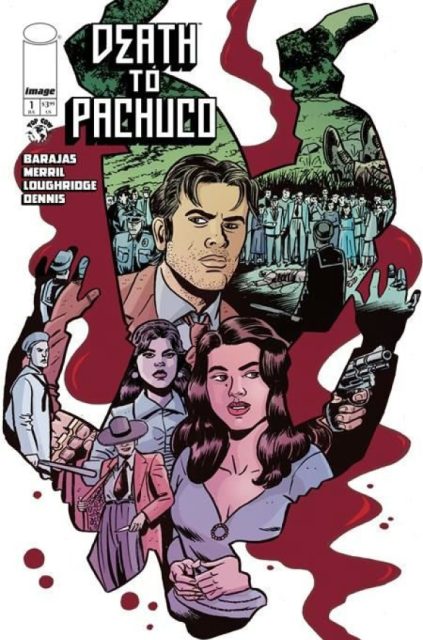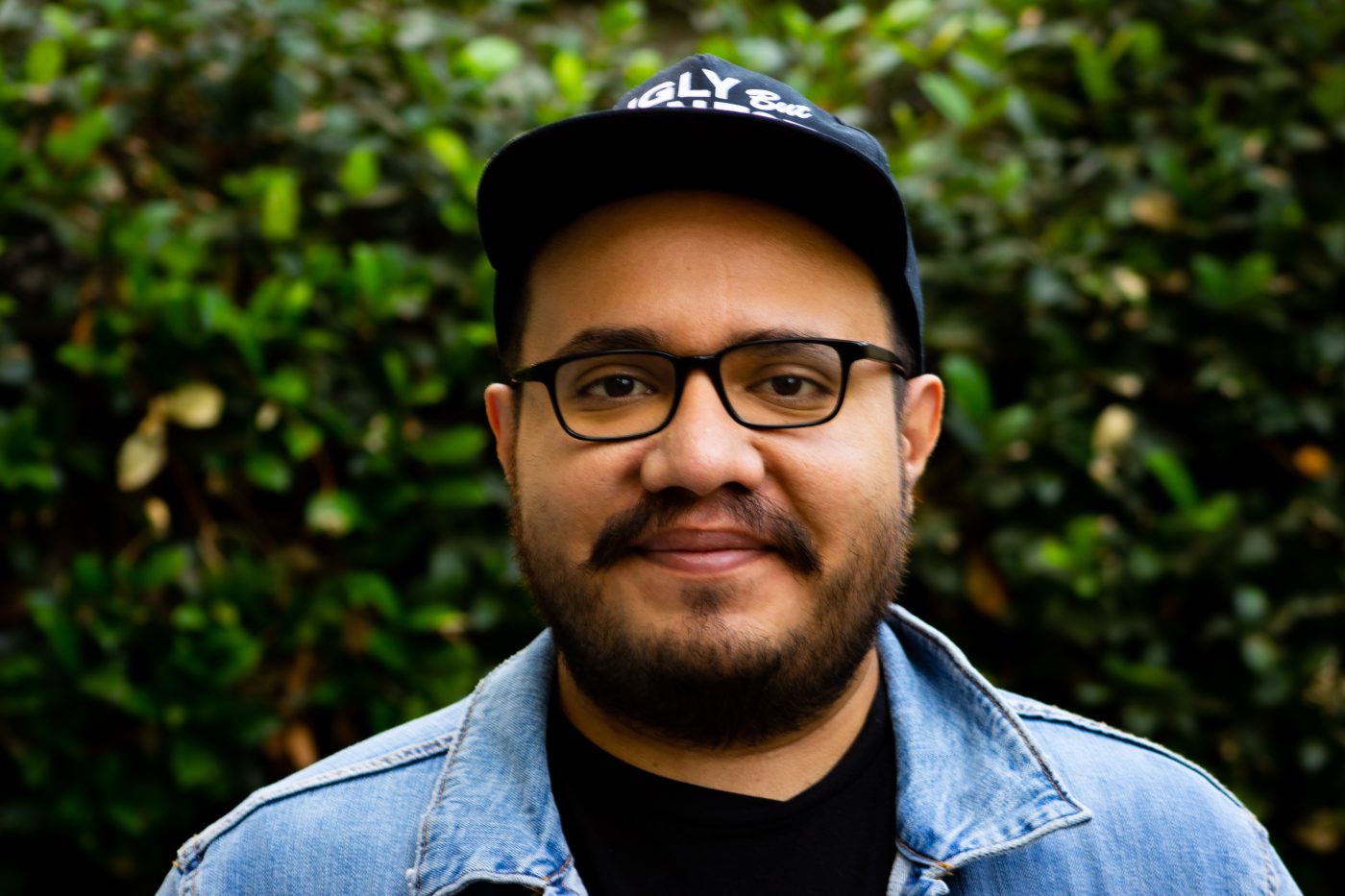Gil Thorp is an old name in the newspaper comic industry, dating back to 1958 in its depiction of the titular high school coach dealing with various sports-related dramas, and it was often segregated into the sports page of the newspaper. The hiring of Henry Barajas in 2022 as writer and Rachel Merrill as artist in 2024, however, has brought the strip into a new era — something taken into sharp relief with the recent July 4 strip, which made an overtly (and rather pointed) political statement about the Trump administration.
In addition to Gil Thorp, the pair have also collaborated on the upcoming Death to Pachuo from Image, about the Zoot Suit riots of 1943, which has more relevance to Gil Thorp than you might think. Both were gracious enough to agree to an interview with The Comics Journal.

WILLIAM SCHWARTZ: How did you get the idea to make an "anti-celebration" strip like this? Many newspaper comics do generic holiday celebration strips. This is the first time I can recall anyone inverting the format like you did here.
RACHEL MERRILL: From what I understand, our editor Carrie Williams was the one who suggested the idea of the strip commenting on the general horror of the current political landscape on America's so-called "birthday."
Henry in the past had us mark other holidays such as Indigenous People's Day. This tied in directly to Gil Thorp since the character himself is based on Jim Thorpe, the legendary Olympian, who was part of the Sac and Fox nation. The July 4 strip feels like a continuation of what Gil Thorp already does for certain holidays.
HENRY BARAJAS: Rachel is really keen on fashion. One of the many reasons why she’s perfect for Death to Pachuco is because the zoot suit has a life of its own, so it needed someone who could appreciate that. I knew she would like to draw a prom story, but our editor suggested “making a statement on the state of the country.”
The Fourth of July strip is a jarring shift from the kids attending their prom to making a statement. I wanted it to be like an after-school special where the cast of characters addresses the powers that be who are listening and own the news outlets where the strip lives in and sits between strips like Garfield and Peanuts. It was meant to make you stop and pay attention to what’s going on around you.
 Tell us a little more about Death to Pachuco. Why did you want to write about the zoot suit riots, and what specifically about the zoot suit itself is Rachel especially well-capable of capturing?
Tell us a little more about Death to Pachuco. Why did you want to write about the zoot suit riots, and what specifically about the zoot suit itself is Rachel especially well-capable of capturing?
BARAJAS: Death to Pachuco was born at the County Library in East L.A. I was doing research on Dolores Huerta and the migrant farmworkers movement at the Chicano Resource Center for an educational comic published by the New York City Department of Education’s Civics For All. Huerta’s brother was harassed for wearing a zoot suit, which led me down the rabbit hole of the 1943 riots all throughout East L.A. and [other] major cities. The fact that the female Pachucas were not afforded the same resources and press as the men facing extreme capital punishments got me asking a lot of questions, which ultimately is what Death to Pachuco’s central plot. What if a mother of the accused hired a Mexican-American private investigator that had to do what the police wouldn’t — find out who really killed "Carlos Urbano" at the Sleep Lagoon. A mutual friend shared Rachel’s work and I appreciated how she used heavy inks in her Adult Romance comic that was formerly on Gumroad before they started censoring NSFW art. It was obvious from her portfolio that she appreciated film, and that is the vibe I wanted to bring to this project. Rachel’s unflinching attitude to work on such a grim time period has me in awe of her not only her artistic abilities, but her bravery to tell a story that will most certainly garner the kind of attention we got on July 4 through Gil Thorp.
Comics are nuclear, and we ain’t wearing hazmat suits.
MERRILL: Henry approached me first with Gil Thorp since they needed to settle on an artist quickly because of the tight deadline that comic operates on. As he already said, once I was official for Gil, Henry sent me the script for Death to Pachuco and a little info about why he thought I would be a good fit for it. Within the first three pages I was set on wanting to work with Henry on the project. It combined my interest in historical narrative and it was the best script I've ever been given for a comic. Obviously, the zoot suit being a central element, fashion is an important detail of both the visuals and the story. I love the chance to draw folks from that time period with the specificity you'd see today. As a bonus, my grandfather was an avid photographer during the time period and I was able to work off of his old photographs as well as the work of Mike Disfarmer.
How did you come to be hired for Gil Thorp in the first place? Did the Tribune Content Agency have anything particular in mind when they scouted you? What has their response been to the July 4 strip?
MERRILL: I owe all that directly to Henry. Initially, he had planned to approach me about doing the interior art/collaborating on Death To Pachuco together, but he and Tribune Agency received word that Rod Whigham was planning to retire — and so Henry offered my name up to the head of acquisitions, Christine St. Joseph. She had me go through several tests to see if I could draw Gil and the cast to the level they had come to expect from Rod's run as Gil Thorp's artist.
BARAJAS: My good friend, collaborator, and former boss Alex Segura passed my resume along. I used to work for the Arizona Daily Star and the Tucson Weekly before I moved to Los Angeles to break in the comic business. I was upfront with the kind of stories I wanted to tell. My pitch was Ted Lasso, but, in high school. I wanted to use this rare real estate to say what was on my mind. As a former journalist in Arizona, I know my audience. The readers are familiar with difficult, real-world news — and they’re vocal. The strip was removed from a number of papers because of a previous author’s choice to have Gil Thorp talk a student into getting an abortion. ... The strip never really recovered from that, so I decided to bring the character who had the kid back all these years later, making Tobias Gordon one of the first syndicated trans-masculine characters. My goal is to honor the original creator’s vision by talking to the kids and parents who deal with high school issues and the sports drama while having fun with it.

Did the two of you discuss the July 4 strip in advance? If so, to what extent did you collaborate?
MERRILL: We do have general discussions, but we didn't with the 4th strip. It was fully fleshed out when it arrived to me in script form. That said, Henry and I are often on the same wavelength when it comes to how the strip should be depicted, and the July 4 strip is a good example of that.
BARAJAS: Due to the nature of how quickly we have to turn this around, we didn’t have time to talk. My goal was to say a lot of shit out loud that needs to be heard. I imagined the strip without a background, but Rachel drew the American flag. The strip is colored by Andrews McMeel, and the in-house colorist didn’t color the flag. And because we work so far ahead, I forgot what was running on that Friday until Rachel texted me.
In general, how much do you two discuss what sort of plotlines you want to do going forward?
MERRILL: Very generally. It's Henry's show script-wise but sometimes I'll mention a funny real event (my niece is a high school teacher) for him to use if he cares to. That said, I have a great deal of input on the costuming and styling and Henry has always been wonderfully receptive to all my unhinged suggestions!
BARAJAS: Rachel will text or call with some great ideas and concepts because of her nieces and nephews. Rachel started drawing the strip when Gil Thorp’s kid, Keri Thorp, was dealing with an eating disorder. We had a few conversations about handling it respectfully, and she was great to work with on that front.

How granular are the illustrative instructions? Whose idea was it for Keri to have those big wordy earrings?
MERRILL: Often references are provided if Henry has something specific in mind. But I get a great deal of leeway, such as the earrings! Sorry To Bother You by Boots Riley is one of my favorite movies and I am forever obsessed with Tessa Thompson's earrings in the film. So Keri having a variety of giant earrings is me scratching that itch.
BARAJAS: My buddy and former Star colleague, Kelly Presnell, takes incredible sports shots for The Star. I try to give Rachel references for everything, so she’s not having to think too much about the strip because our schedule is brutal. I know she hates when I say this, but I would kill for a Sunday edition so we can print it in color.

As easy as it is to fixate on the July 4 strip, Gil Thorp has been flirting with progressive social issues for quite some time. Keri, for example, is gender non-conforming, I believe? Where did this idea come from?
MERRILL: Keri's identity pre-dates me coming on board, but they've become my favorite character to draw. A lot of my influence in how Keri is depicted comes from celebrities like Emma Corrin, who is also gender nonconforming and quite a fashion darling too. I want Keri to have a lot of specificity to their look in ways that don't just read as a flat depiction of how they chose to identify.
BARAJAS: The previous writer stopped including the kids in his story, so the diehard fans would always make references to them in the comments. My goal was to make Gil the main character of his book. I think every serialized story becomes more about the ensemble than the titular character.
Is there that much difference from the Neal Rubin era, really, or have you just been heading in the same direction? I vaguely remember a plotline about a teen mom on the soccer team, I think.
MERRILL: I wasn't aware of Gil Thorp until I was approached about becoming the new lead artist. From what I've gathered in the archive, Henry's worked to make the strip feel a bit more contemporary.
BARAJAS: I wanted to step out of the Rubin era and cast my own shadow. In some ways, Keri has become the kid I wish I had and was. Many of my friends have nonbinary or trans kids, and they’re scared shitless. I wanted the high school drama to bleed into every aspect of his life and redirect the electric current back to him while keeping it a sports-centric strip.

It can be difficult to keep track of what's going on in Gil Thorp on a daily basis. How are you able to maintain continuity?
MERRILL: Drawing six 3-4 panel strips each week helps sink in who everyone is pretty easily. I've also been slowly changing some of the supporting characters designs to help avoid confusion with such a big cast.
BARAJAS: The last three years I’ve kept the same roster of coaches, students, and athletes except for introducing new characters once or twice a year. Previous writers followed Jack’s lead to introduce a whole new class every season. That means you have to establish new characters for every sport season. I wanted to simplify that process by keeping it grounded to the same cast, so we’re not starting from square one four times a year. But the magic behind a daily strip is to give you enough information of what’s going on today while building on yesterday, and making them come back tomorrow. It’s a fun exercise I love to do daily.
Shortly before Rachel became the head artist, the titular Gil Thorp seemed to have a near-death experience, presumably to explain the art style shift. Was there any deeper reason behind the change than that, or is the art just the art, a different interpretation of the same characters?
MERRILL: Henry asked Rod what he liked drawing best, which was airplanes, and he took that concept as a way of reintroducing Gil and allowing me the runway (sorry) to introduce the new style for the comic strip.
BARAJAS: Rod never missed a strip. He is one of the best artists I’ve ever worked with. I asked him what did he like to draw when we had our first and only Zoom call. He then gestured towards the model planes suspending around him and on his shelves. I wanted him to sunset his incredible run drawing what he loves.

Is Marty Moon really committed to this whole shaman bit, or would exploring this too much take us too far away from the central premise of this comic being about sports at a high school?
MERRILL: I think this may be a mix-up with Coach Luke Martinez – going forward, Marty Moon is sporting a Magnum P.I. mustache so hopefully there will be less confusion between the two going forward.
BARAJAS: Again, due the the quick turnaround time, a lot of Rod’s characters have very similar traits. Luke Martinez and Marty Moon had the same facial hair, which lead Rachel giving Marty a “new to him” Magnum P.I. look when he got sober, again. But Gil Thorp had a supernatural element to it during Neal’s run. I wanted to talk about how some people believe in ghosts. Luke’s journey in Milford is a long and comical one. I will always use that character to have fun with the strip.
In your mind, does Gil Thorp or a Gil Thorp-adjacent character coach every sport, or just the important ones? In the latter case, how do you define importance?
MERRILL: If we could get every newspaper in Texas to pick up Gil Thorp without a doubt it would be football all year round.
BARAJAS: Jack Berrill made Gil coach every sport, so that’s been the theme. I love that Gil can do sport, but some seasons he comes short. It’s a good balance to not make him an unbeatable character while showing there is grace and something to be learned in a loss.
Any final thoughts? What's going on with Death to Pachuco?
MERRILL: Going back to why Henry initially approached me, Death To Pachuco has just been announced as a limited run series by Image Comics. Although set in 1943 during the Zoot Suit Riots, like Gil Thorp, it deals with issues that are sadly still relevant today. You can pick up the first issue Oct. 8.
BARAJAS: I’m lucky to find a collaborator and friendship with Rachel. We both have stories to tell and something to prove. If all goes according to plan, we will be making comics together for the foreseeable future.
The post <i>Gil Thorp’s</i> Rachel Merrill and Henry Barajas talk politics, comic strips and the zoot suit riots appeared first on The Comics Journal.

No comments:
Post a Comment